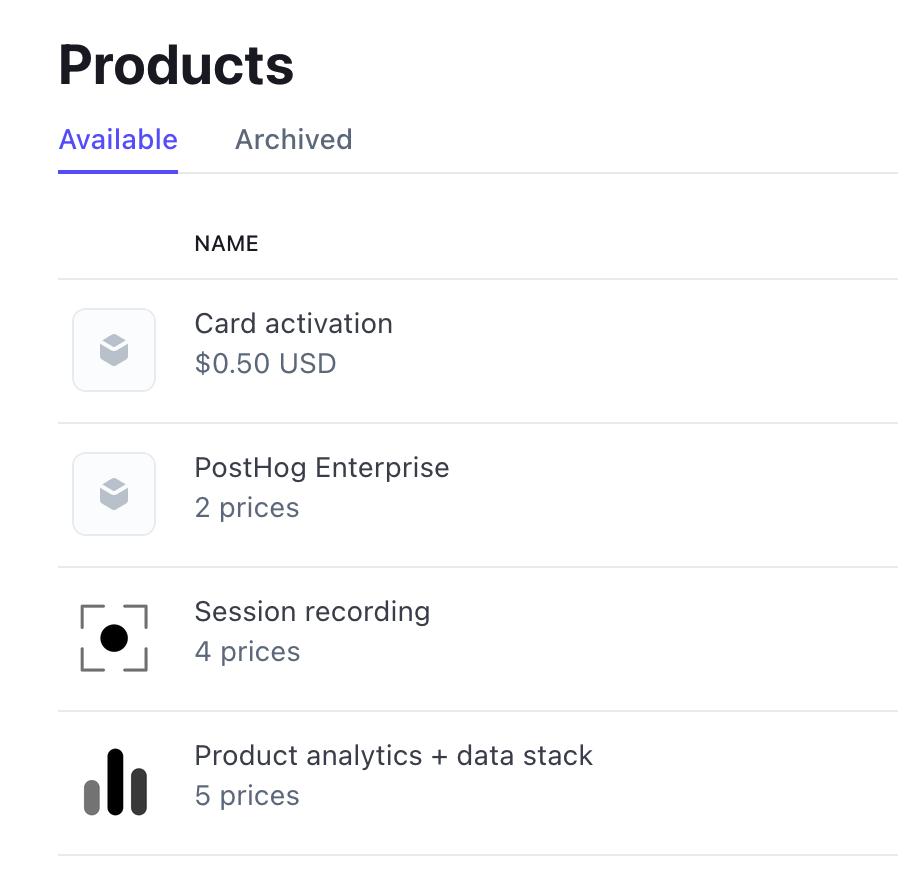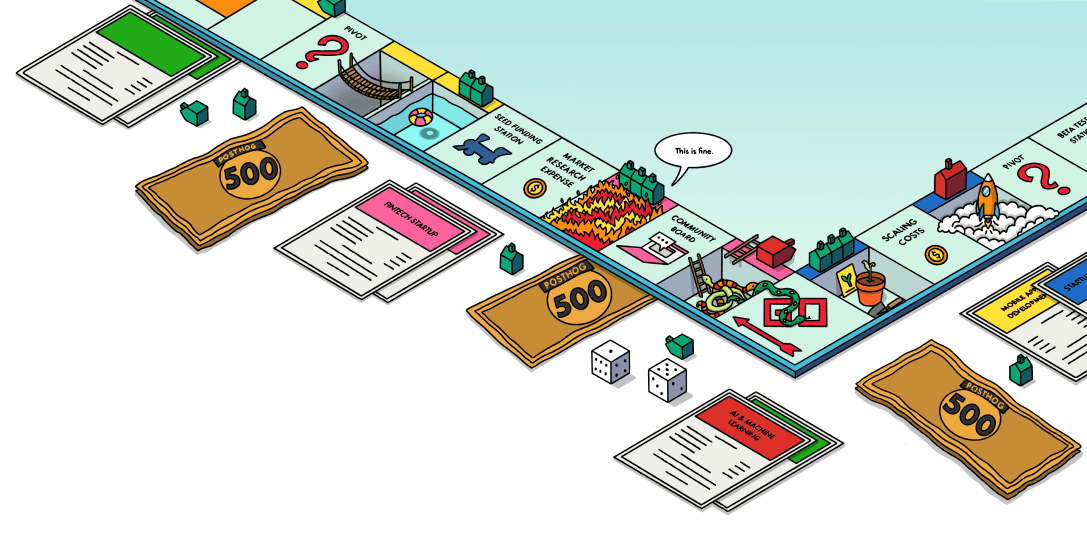Billing
Contents
Managing billing
This section explains how PostHog's billing system works. Most billing operations described below are handled exclusively by the
Billing Team
All PostHog instances talk to a common external Billing Service. This service is the single point for managing billing across PostHog Cloud US, PostHog Cloud EU (and ,formerly, self-hosted customers).
The Billing Service is the source of truth for product information, what plans are offered on those products (eg a free vs a paid plan on Session Replay), and feature entitlements on those plans. Our payment provider Stripe is the source of truth for customer information, invoices, and payments. The billing service communicates with Stripe to pull all the relevant information together before responding to customer requests.
Credit-based Plan Automation
To ensure consistency in the setup of credit-based plans we have Zapier Automation to take care of all of the Stripe-related object setup.
Loading contract details
Once an Order Form is closed in PandaDoc, Zapier will add a new row to the Credit-based Plan Table with the PandaDoc ID of the document. The table will have the following information automatically filled in: PandaDoc Order Form, Company Name, Customer Email, Credit Amount, Discount, Price, Start Date, Term, PostHog Org ID.
Upfront Payment Setup
Step 1: Update Zapier table with existing Stripe ID
If this is a new contract for an existing customer, you will need to add their existing Stripe Customer ID manually to the table. You can find this information in Vitally under Traits. If this is a brand new customer, click “Create Stripe Customer” button to assign them a new ID.
Step 2: Create invoice
- Go to the Credit-based Plan Table and click “Create Invoice - Upfront”. This will:
- Create a draft Invoice object against the Stripe Customer Object.
- Add the ID of the Invoice to the table (for easy review later on). The due date of the invoice will be the Contract Start Date + 30 days which are our standard payment terms. You might need to manually change this if we have different terms with the customer.
Step 3: Verify invoice details and send
- Click the invoice link in the table to open it in Stripe, or use the Invoice ID to locate the invoice in Stripe.
- Ensure all details are correct, particularly the Customer’s Billing/Shipping addresses and Tax ID on the Customer object.
- If the customer has an existing credit balance in Stripe (common for renewals), remove the credit before sending the invoice. Otherwise, Stripe will automatically apply the credit balance to the invoice. After the invoice is sent, you can reapply the credit.
- Send the invoice to the customer and wait for the payment to be completed. Ensure that the customer is aware that payment is via Bank Transfer only (no checks).
Do not proceed to the next steps until invoice is finalized. Any credits added to an account gets automatically applied to outstanding invoices. If you add credits before payment is completed, the credits will settle any existing debts, and customer will not be able to make a payment.
For customers using Bill.com for payment, when they submit the invoice to the Bill platform it strips out the Stripe virtual account details. You'll need to ask them to follow the instructions in this help article to set the correct bank details for us in the Bill.com platform. The account details is provided in the invoice sent over. They'll need to make sure they use the original contact information and not your email if you're set as signer on the contract so we can process payments in the right account. In case they don't do this, we have a default customer account on Stripe which the money will go to. If this happens, mark their invoice as paid manually and then generate a new one against our default customer account to use the funds.
Step 4: Apply credits
- Make sure that the payment is fully processed to avoid any automatic deductions.
- If customer wishes to begin using credits immediately: return to the Zapier table after you’ve verified payment completion and click the "Apply Credit" button.
- If customer wishes to begin using credits in the next billing cycle: ask the RevOps team to apply the credits at the end of the current billing cycle.
Step 5: Schedule subscription
- If the client has an existing subscription, no further action is needed.
- If this is a brand new account:
- Select checkboxes for all the products the client intends to use as part of their subscription.
- Click the "Schedule Subscription" button. Using the data from the table row where the button was clicked, this will:
- Consolidate all of the Price IDs into a query string which the Stripe API accepts.
- Create a Subscription Schedule (as it may start in the future) containing all of the prices. We calculate the number of iterations based on the term of the contract. An iteration in this case is 1 year, the maximum allowed by Stripe.
- Add the ID of the Subscription Schedule to the table
Failed/late payments
We define late payments as follows:
- For credit-based customers, that have not made payment on an invoice and their due date has passed. The first invoice is usually 30 days from the contract start date (Net 30) although can differ based on other contractual terms. This rule applies to all payment terms, including and not limited to annual and quarterly, regardless whether there are still credits available or not.
- For pay-as-you-go usage-based customers, we will attempt 4 automated payments using the card we have on file. Each failed payment sends an alert to the #sales-alerts Slack channel. After 4 failed payments we will stop attempting to take further payments.
In either of the above scenarios the account owner as defined in Vitally needs to take action to ensure that payment is made. If there is no owner in Vitally, Simon will handle this process. If you are an AE, remember this also has impact on your commission, as we don't pay out until the customer has paid their invoice.
You can find a list of failed and overdue payments in PostHog
Step 1 - On the day their payment becomes late
As the account owner you will be assigned a risk indicator in Vitally, as well as being tagged in an alert in #sales-alerts. For unmanaged accounts with a failed payment of $1500 or more Simon and Dana are tagged instead.
You should reach out to any known contacts, as well as any finance email addresses we have in Stripe asking for payment to be made immediately. For credit-based customers, you can download the Invoice PDF from the Stripe invoice page, and for monthly customers you can get the payment link from the Stripe invoice page. To get a payment update link, click on the subscription, then click actions in the top right corner and choose share payment update link. Make it easy for them to make payment by including these details in your email.
Make it clear in this outreach that if we don't receive payment in the next 7 calendar days, their user access will be suspended. If they come back to you with genuine reasons why they need more time, use your discretion with the next steps.
Step 2 - 1 day before suspending user access
Reach out to all active users on the account, and let them know that access will be suspended tomorrow due to the failed payment. This often creates urgency and will get any late payment resolved.
Step 3 - Suspending user access
To prevent users from being able to log in you need to go to the Django admin panel for their organization, then for each user account listed there open the user, uncheck the Is Active box and then save the user.
After completing this, email or Slack all users in the organization letting them know that access has been suspended and what they can do to rectify the situation. Also make it clear that if this isn't resolved within the next 7 days we will revert them back to the Free tier and they be subjected to the usage limits of that tier (e.g. they are likely to lose tracking data).
If they do pay after this point make sure to re-enable user access by reversing the above in Django admin.
Step 4 - 1 day before cancelling their subscription
Reach out to all contacts letting them know that due to the failed payment we will be terminating their subscription tomorrow.
Make it clear in this outreach that once the subscription is terminated they will be subject to the free tier usage limits and we won't store any data above that limit.
Step 5 - Cancelling their subscription
You can cancel their subscription in Stripe - navigate to their Stripe customer page, and then click the ... next to their active subscription to find the Cancel option.
At this point they will be notified about this automatically via the billing service.
Repeated failed payments
After three consecutive missed payment periods, the customer must provide advance payment covering three months of service based on their typical usage before account access is restored. If the customer disagrees or fails to make the advance payment, the account may be reverted to the Free Tier.
Stripe Products & Prices
⚠️ Product and price modifications are restricted and handled exclusively by the
Billing Team
Each of our billable Products has an entry in Stripe with each Product having multiple Prices. We use a billing config file to determine what is shown in the UI and how billing should behave. We use very limited metadata on some of these prices to allow the Billing Service to appropriately load and offer products to the instances:

Custom metadata
On Stripe Products
posthog_product_key:posthog_analytics|session_replay| ... -> This allows PostHog to find and map the relevant products. Important: There should never be more than 1 Stripe product with the sameposthog_product_key. The list of keys is defined in the main billing config.
On Stripe Product Prices The following keys are used to manage Startup prices:
plan- Any Startup plan prices must have theplanmetadata set tostartupto have their subscription automatically moved to the default (paid) prices. If not, when their subscription ends they will instead be switched to the free plans for all products.valid_days-> The number of days a price is valid for, before automatically switching to another plan (thedefaultplan unlessmove_to_price_idis set). Useful to create pricing that is only valid for a specific period, e.g. for the startup plans. Note: if more than one price withvalid_daysis added to a subscription, the validity period will be the shortest of the two, before resetting all plans to the default onesmove_to_price_id-> Can be used to specify if the customer needs to be moved to a specific pricing, rather than the default one, at the end of the subscription period.
Working with pricing
Each Product has multiple prices that can be used in a subscription. Which price is default depends on the billing config file.
The default price in Stripe does not affect the actual default price for a product. This is instead defined in the billing config.
In general, if coming from the UI, a customer will subscribe to certain prices depending on the config. There are special prices named Free which can be used to give a product for free. These can be added manually and are typically used for Enterprisey customers who pay a flat fee up-front and $0 for the actual usage (which we still want to track but not charge for).
Types of billing plans we support
We generally support the following types of billing plans:
- Standard metered
- This includes usage-based and metered, even if it has custom price tiers or is a special program like the Startup program.
- Metered, but with discount coupon
- Flat first tier, metered after
- Up-front payment, $0 first tier, metered after
- Flat up-front, no metering (renegotiate contract if they go over)
If at all possible, it's best to stay with these types of billing plans because we already support them, and adding extra stuff will increase complexity. If you do need to add a different type of billing plan, chat with the
Coupons and Discounts
As much as possible the existing prices should be used in combination with Coupons to offer custom deals to customers. Coupons are applied to the Customer in Stripe, not to the customer's subscription.
- Visit the customer in the Stripe dashboard.
- Select Actions -> Apply Coupon.
- Select the coupon to apply.
- The UI should soon reflect the change. If you need it to reflect immediately, use the "Sync selected customers with Stripe" action in Django Admin.
When calculating usage limits, discounts are taken into consideration before the limit is calculated. This means that if the customer sets a billing limit of $200 and has a 20% discount, they will get charged $200 for $250 worth of volume.
Creating new or bespoke prices
- Go to the appropriate product in question (do not create your own Product)
- Click "Add another price"
- Important: For metered products (e.g. Product Analytics, Session Replay), set up the price as follows:
- Select
Recurring,Usage-based,Per tier, andGraduated. - Under Advanced, set the "Metered usage charge method" to
Most recent usage value during period. This is crucial as the Billing Service will send the correct number of units (events, recordings, etc) every day, so any errors that caused excess usage to be reported can self-heal with the next reporting cycle.
- Select
- Expand the
additional optionsand add a straightforward Price Description likeCustom - {date of creation} - Add the tiers as you see fit
- If the custom prices are for a product and addons (eg. Product analytics and Group analytics) the tier volumes need to be exactly the same between the two products/prices. If tier 3 for Product analytics is up to 15M and tier 3 for Group analytics is for 16M, you'll get errors from the billing service).
- If you are making a custom price for just one product (ie. someone is getting special pricing for Product Analytics but will get the normal pricing for Group Analytics), make sure the tiers match up between the main product and the addons.
- Add custom metadata if needed.
Plans
⚠️ Plan modifications are handled exclusively by the
Billing Team
You can find a list of available plans in the billing repo. These are found inside costants/plans, divided by folder.
Each plan can have a list of features, and a price.
Features are used to infer which features are available in the product, for a customer on that plan.
You can manually change the plan for a customer by updating the plans_map in the billing admin panel.
Updating subscriptions
Stripe subscriptions can be modified relatively freely for example if moving to a custom pricing plan.

- Look up the customer on [Stripe dashboard][stripe_dashboard] using their email address or Stripe ID (this can be found in the Billing Service admin under
Customers). - Click on the customer's current subscription.
- Click on Update subscription.
- Remove the old item from the pricing table and add the new item.
- Enterprise: Use existing enterprise prices or create new ones.
- Startup plan: Use existing Startup plan prices.
- Click on Update subscription. Do not schedule the update for a later time. There will be unintended side effects if the changes are not applied immediately.
- Do not prorate the subscription.
- The changes should be reflected for the user within a few minutes.
NOTE: Removing a metered product price (events, recordings) and adding a new price will likely reset the usage. This is fine as the Billing Service will update it during the next sync.
Self-hosted differences
Self-hosted billing is no longer supported except for legacy customers who were using the paid kubernetes deployment.
Billing for data pipelines
For information about data pipeline pricing and billing, please visit our pricing page.









